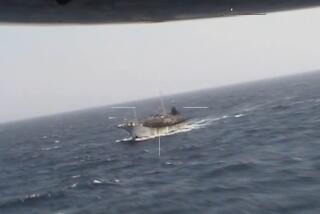Dolphins: Unwitting Lure for Industrial Fishermen
- Share via
Along rivers throughout the South American rain forest, the rare pink freshwater dolphin has traditionally been considered magical, capable of changing at will into human form to seduce people into amorous adventures. Supposedly helpless to resist the charms of the supple dolphin come-to-land, men and women sometimes explain away romantic infidelities with a wry, “The dolphin made me do it.”
It is easy for us to admire dolphins because they are sleek, lustrous, keenly intelligent. Whether it was this affinity that gave birth to the popular lore of transformation, no one knows. But clearly the legend brings the animals esteem--in this region that celebrates their mythical properties, they are rarely hunted.
However, dolphins are used to locate schools of fish, especially in the dry season when receding water levels in the river pack fish tightly together. A fisherman watches from a high tree near shore, and when he spots dolphins arching through the water surface, he signals other fishermen waiting below in canoes. These fishermen paddle madly into the river and toss a ring of netting into the splashing waters, hoping to snare some of the fish on which the dolphins have been feeding. Any dolphins caught in the nets are gently released by the fishermen, who show the care of a parent attending a sick child.
On this small scale--one boat, a handful of men and a subsistence level of fishing--dolphins escape a premature death. But not when the scene changes to industrial tuna fishing in the warm Pacific. For years, we have been wrestling with the grisly problem of yellowfin tuna fleets that kill ocean-going dolphins by inadvertently catching them in purse-seine nets. Official U.S. statistics estimate that nearly 2 million dolphins were killed by fishing fleets in these waters between 1972 and 1988.
For reasons that are still unclear, various species of salt-water dolphins travel with schools of yellowfin (light) tuna. Taking advantage of this association, fleets use dolphins as living sonar to locate tuna swimming well below the surface. Once sighted, the tuna--and thus the dolphins--are herded together, sometimes by the use of explosives. Then the fishermen toss their nets, tightening them in a circle to trap the tuna and, sadly, many dolphins.
Dolphins that are not maimed by the explosions can easily drown if they are not quickly freed to reach the surface, because they are air-breathing mammals.
The worldwide killing of dolphins in this process gave impetus to passage in the United States of the Marine Mammal Protection Act in 1972.
Originally, the MMPA--which regulated all ships flying a U.S. flag as well as all ships in U.S. waters--intended to reduce the “incidental kill or incidental serious injury of marine mammals permitted in the course of commercial fishing operations . . . to insignificant levels approaching a zero mortality and serious injury rate.” But in the intervening years, lobbying by the tuna industry, combined with changing political priorities in the United States, weakened the MMPA.
During the same period, the tuna industry began to rely more heavily on ships flying other national flags. I’ve seen such ships at work in Mexico, Panama and Costa Rica. When the MMPA was re-authorized in 1988, it at least required that by 1990 any ship exporting tuna to the United States limit its rate of dolphin killed per ton of tuna fished.
The tuna industry says it is doing everything possible to prevent dolphin kills, but this claim cannot be verified. Indeed, new techniques were introduced in the 1970s that had begun to reduce dolphin casualties, and the re-authorized MMPA calls for placing observers aboard all U.S.-flagged boats, as well as other controls, such as a ban on setting nets after sundown, which is when much dolphin mortality takes place. Foreign fleets must implement a “comparable” program of controls.
Some environmentalists remain unsatisfied with the situation, however, and are calling for a boycott of canned tuna--even albacore and bonito that are not involved in dolphin deaths.
I believe that very few fishermen in any country have a desire to slaughter dolphins. And the fishing industry remains the key player in forging any satisfactory solution.
Dolphins do not feed on yellowfin tuna, and yet the two are drawn together in a mysterious relationship that may influence their mutual survival. Perhaps only respect for the dolphin--etched in the myth of the South American rain forest--will stop us from turning this positive association into a deadly trap.
More to Read
Sign up for Essential California
The most important California stories and recommendations in your inbox every morning.
You may occasionally receive promotional content from the Los Angeles Times.













